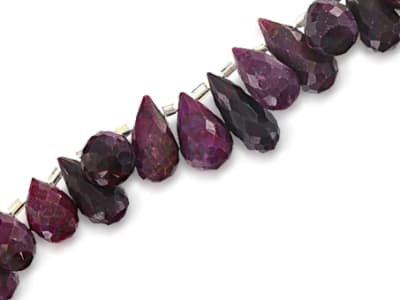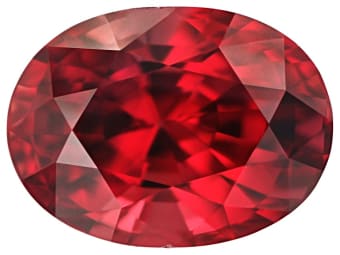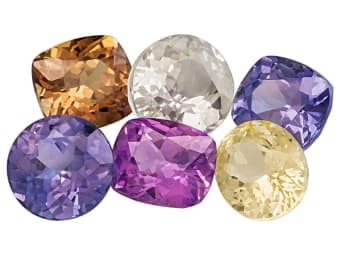Corundum is a mineral species best known for its two popular gemstone varieties, sapphire and ruby. All colors of corundum except red are known as sapphire. The term sapphire, when used without any modifiers, refers to only the blue variety of corundum. Red stones are known as ruby. Material that are not gemstones are simply known by the name corundum.
General Information
Corundum Colors
-
 Black
Black -
 Blue
Blue -
 Brown
Brown -
 Gray
Gray -
 Green
Green -
 Orange
Orange -
 Pink
Pink -
 Purple
Purple -
 Red
Red -
 White
White -
 Yellow
Yellow
Corundum Spectra
We acknowledge the significant scientific contributions of John S Harris, FGA to the study of gemstone spectra and with deep appreciation to him, acknowledges the use of his images and related notes about gemstones and their spectra in the educational materials on this website.
Countries of Origin
Papua New Guinea; Cambodia; Kazakhstan; Paraguay; Bahamas; Solomon Islands; Montserrat; Unknown; Mali; Marshall Islands; Guadeloupe; Panama; Bonaire, Sint Eustatius and Saba; Argentina; Seychelles; Belize; Zambia; Bahrain; Congo; Guinea-Bissau; Saint Barthelemy; Namibia; Comoros; Faroe Islands; Finland; Georgia; Yemen; Tanzania, United Republic Of; Eritrea; Puerto Rico; Viet Nam; Aruba; Madagascar; Libya; Sweden; Cocos (Keeling) Islands; Malawi; Andorra; Saint Helena, Ascension and Tristan da Cunha; Liechtenstein; Poland; Bulgaria; Jordan; Tunisia; Tuvalu; United Arab Emirates; Kenya; French Polynesia; Djibouti; Lebanon; Azerbaijan; Cuba; Mauritania; Saint Lucia; Guernsey; Congo (the Democratic Republic of the); Mayotte; Israel; San Marino; Australia; Tajikistan; Myanmar; Cameroon; Gibraltar; Cyprus; Northern Mariana Islands; Malaysia; Iceland; Oman; Bosnia And Herzegovina; Armenia; Gabon; Korea (the Republic of); Luxembourg; Brazil; Turks and Caicos Islands; Algeria; Cabo Verde; Jersey; Slovenia; Colombia; Ecuador; Iran (Islamic Republic of); Lao People's Democratic Republic; Vanuatu; United States Minor Outlying Islands; Honduras; Italy; Antarctica; Nauru; Haiti; Afghanistan; Burundi; Russian Federation; Singapore; French Guiana; American Samoa; Christmas Island; Netherlands; China; Martinique; Kyrgyzstan; Reunion; Saint Pierre And Miquelon; Cote D'Ivoire; Bhutan; Multiple; Romania; Falkland Islands [Malvinas]; Togo; Philippines; Uzbekistan; Pitcairn; Zimbabwe; British Indian Ocean Territory; Montenegro; Dominica; Indonesia; Benin; Angola; Virgin Islands (British); Sudan; Brunei Darussalam; Portugal; New Caledonia; Grenada; Moldova (the Republic of); Cayman Islands; Greece; Latvia; Mongolia; Morocco; Guatemala; Guyana; Iraq; Chile; Nepal; Isle of Man; Ukraine; Ghana; Holy See; Anguilla; Saint Vincent And The Grenadines; India; Canada; Maldives; Turkey; Belgium; South Africa; Bermuda; Aland Islands; Central African Republic; Jamaica; Peru; Turkmenistan; Venezuela (Bolivarian Republic of); Germany; Fiji; Tokelau; Hong Kong; Guinea; Chad; Somalia; Thailand; United Kingdom of Great Britain and Northern Ireland; Equatorial Guinea; Kiribati; Costa Rica; Saint Martin (French part); Kuwait; Nigeria; Palestine, State of; Croatia; Sao Tome And Principe; Syrian Arab Republic; Cook Islands; Sri Lanka; Uruguay; Timor-Leste; Switzerland; Samoa; Spain; Liberia; Burkina Faso; Swaziland; Palau; Estonia; Wallis and Futuna; Niue; Svalbard And Jan Mayen; Austria; Mozambique; El Salvador; Monaco; Guam; Lesotho; Tonga; Heard Island And Mcdonald Islands; Western Sahara; Hungary; Republic of Kosovo; South Sudan; Japan; Belarus; Curacao; Mauritius; Taiwan (Province of China); Bouvet Island; Albania; Bolivia (Plurinational State of); Norfolk Island; Trinidad And Tobago; Virgin Islands (U.S.); New Zealand; Sint Maarten (Dutch part); Senegal; Micronesia (Federated States of); Ethiopia; Macedonia (the former Yugoslav Republic of); Czechia; United States of America; Egypt; Sierra Leone; Malta; Saudi Arabia; South Georgia And The South Sandwich Islands; Pakistan; Gambia; Ireland; Qatar; Slovakia; France; Lithuania; Serbia; Niger; Rwanda; Saint Kitts And Nevis; French Southern Territories; Bangladesh; Barbados; Nicaragua; Norway; Botswana; Macao; Denmark; Dominican Republic; Mexico; Uganda; Suriname; Greenland; Antigua And Barbuda
Care
Normal care
Species/Variety
Ruby
Ruby is the red gem grade variety of corundum.
Sapphire and Fancy Sapphire
Gem grade blue corundum is known as sapphire. If the material is any other color of than blue or red it is a fancy sapphire.













